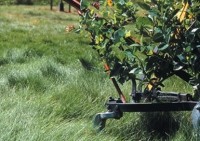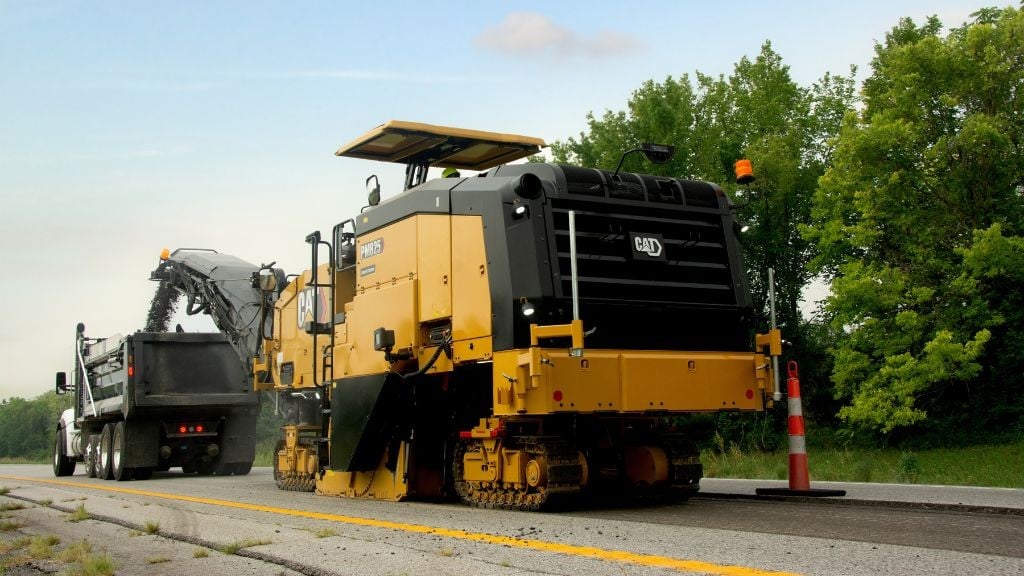
The Alexandra and Marine General Hospital in Goderich, Ontario, is one of the latest public facilities to choose Eco-Lawn to reduce its energy footprint and save money.
Eco-Lawn was developed by Wildflower Farm, based out of Orillia, Ontario, and is a specially formulated blend of seven fine fescue grasses that thrives in all climates and conditions, including full sun, part shade and even deep shade. The lawn is virtually maintenance-free as it germinates quickly, and turns into a slow growing grass that only needs to be cut once a month. The roots also grow deeper into the earth than traditional turf grasses, getting nutrients and water required naturally so there is no need for fertilizer or watering. “When our town council banned pesticides, the obvious next question was: what was the alternative?” said Raymond Letheren, chair of the Hospital Green Committee, that recommended Eco-Lawn. “It didn’t take long for our research to point to Eco-Lawn as the solution. Eco-Lawn requires very little mowing, which is huge considering mowers and leaf blowers are proven to cause more pollution than an SUV while running for 20 minutes in the course of a day.” “Eco-Lawn has been installed at a number of large scale municipal projects throughout Canada from the city of Kelowna, British Columbia to Barrie, Ontario.” states Miriam Goldberger, president of Wildflower Farms, the company that developed the sustainable product about ten years ago. “As more and more municipalities ban pesticides or institutions look for ways to reduce costs, sustainable landscaping is gaining ground.” Goldberger adds.
Other facilities using Eco-Lawn include Toyota Canada in Toronto, the new Cirque de Soleil headquarters in Montreal and the Canadian Air Force base in Shilo, Manitoba.
It is also economical. The cost of putting in the hospital lawn in Goder-ich was $1,500 (including the cost of preparing the lawn for seeding.) The actual cost of the lawn seed for this project was $149.75 (based on $29.95 for a five-pound bag that covers 1,000 sq. ft.) By comparison an equivalent-sized traditional turf lawn would cost approximately $26,000 over ten years to maintain through watering, fertilization, aeration and lawn mowing once a week. “This is the logical landscaping choice for the 21st Century,” said Miriam Goldberger, the president of Wildflower Farm. “Eco-Lawn produces a thick, handsome turf, and it requires minimal effort and resources to maintain. It’s the right lawn for an environmentally stressed world.” A standard Kentucky bluegrass or perennial rye lawn requires one to two inches of water a week. For a 1,000 square foot lawn, that amounts to more than 100,000 thousand gallons of water a year. Eco-Lawn, however, requires minimal watering. In central and southern California, as an example, no more than 17,500 gallons of water are necessary for a 1,000-square-foot Eco-Lawn from April through October, and only 25,600 gallons for the whole year.
Like all turf blends, Eco-Lawn is best sown in the fall. During its first year, it will need some regular watering to help it get established; but by its second year of growth, only minimal watering is required – even during periods of drought.
Its drought tolerance is due to two reasons. First, it produces grass blades that are extremely thin. Typical lawn grass varieties have thick, succulent blades that require a great deal of water to maintain turf structure and health. The thin blades of Eco-Lawn’s fescues are less susceptible to drought. It also has exceptionally deep root systems. Most lawns support roots a few inches in length, necessitating frequent and copious watering. When established, Eco-Lawn’s roots penetrate up to nine inches in hardpan clay and 14 inches in sandy soils, siphoning up residual subterranean moisture throughout the growing season.
Drier lawns also mean fewer lawn pests. June beetles, as an example, flourish in moist lawns, and their grubs can cause significant damage to established turf. Because Eco-Lawn thrives in dry soils, June beetles and their grubs cannot become established, and no pesticides are required.
Deep roots also eliminate the need for fertilizing and weed control; the extensive root system obtains all the nutrients the lawn needs without supplementary feeding or herbicide applications. Finally, Eco-Lawn requires minimal mowing – no more than once a month during the summer, compared to once a week for most Kentucky bluegrass and perennial rye lawns.
Reduced watering, no fertilizers or pesticides, and minimal mowing – it all adds up to a lawn that makes economic as well as environmental sense. According to a study conducted by Wildflower Farm, a 1,000 square foot lawn planted to traditional blends costs $8,075 to install and maintain over a ten-year period. By comparison, the installation and maintenance costs for an Eco-Lawn over the same period of time are $1,500 – a savings of $6,575. “In my opinion drought-tolerant turf is one of the best landscaping choices you can make,” said Michael Brooks, the president of Resource Management Strategies, a consulting firm specializing in water conservation issues. “These kinds of seed blends produce lawns that are both beautiful and extremely drought-tolerant,” Brooks said. “Private homeowners, business complexes and municipalities should all take advantage of them. I consult globally, and I recommend them to clients wherever water availability is an issue.”
Eco-Lawn was developed by Wildflower Farm, based out of Orillia, Ontario, and is a specially formulated blend of seven fine fescue grasses that thrives in all climates and conditions, including full sun, part shade and even deep shade. The lawn is virtually maintenance-free as it germinates quickly, and turns into a slow growing grass that only needs to be cut once a month. The roots also grow deeper into the earth than traditional turf grasses, getting nutrients and water required naturally so there is no need for fertilizer or watering. “When our town council banned pesticides, the obvious next question was: what was the alternative?” said Raymond Letheren, chair of the Hospital Green Committee, that recommended Eco-Lawn. “It didn’t take long for our research to point to Eco-Lawn as the solution. Eco-Lawn requires very little mowing, which is huge considering mowers and leaf blowers are proven to cause more pollution than an SUV while running for 20 minutes in the course of a day.” “Eco-Lawn has been installed at a number of large scale municipal projects throughout Canada from the city of Kelowna, British Columbia to Barrie, Ontario.” states Miriam Goldberger, president of Wildflower Farms, the company that developed the sustainable product about ten years ago. “As more and more municipalities ban pesticides or institutions look for ways to reduce costs, sustainable landscaping is gaining ground.” Goldberger adds.
Other facilities using Eco-Lawn include Toyota Canada in Toronto, the new Cirque de Soleil headquarters in Montreal and the Canadian Air Force base in Shilo, Manitoba.
It is also economical. The cost of putting in the hospital lawn in Goder-ich was $1,500 (including the cost of preparing the lawn for seeding.) The actual cost of the lawn seed for this project was $149.75 (based on $29.95 for a five-pound bag that covers 1,000 sq. ft.) By comparison an equivalent-sized traditional turf lawn would cost approximately $26,000 over ten years to maintain through watering, fertilization, aeration and lawn mowing once a week. “This is the logical landscaping choice for the 21st Century,” said Miriam Goldberger, the president of Wildflower Farm. “Eco-Lawn produces a thick, handsome turf, and it requires minimal effort and resources to maintain. It’s the right lawn for an environmentally stressed world.” A standard Kentucky bluegrass or perennial rye lawn requires one to two inches of water a week. For a 1,000 square foot lawn, that amounts to more than 100,000 thousand gallons of water a year. Eco-Lawn, however, requires minimal watering. In central and southern California, as an example, no more than 17,500 gallons of water are necessary for a 1,000-square-foot Eco-Lawn from April through October, and only 25,600 gallons for the whole year.
Like all turf blends, Eco-Lawn is best sown in the fall. During its first year, it will need some regular watering to help it get established; but by its second year of growth, only minimal watering is required – even during periods of drought.
Its drought tolerance is due to two reasons. First, it produces grass blades that are extremely thin. Typical lawn grass varieties have thick, succulent blades that require a great deal of water to maintain turf structure and health. The thin blades of Eco-Lawn’s fescues are less susceptible to drought. It also has exceptionally deep root systems. Most lawns support roots a few inches in length, necessitating frequent and copious watering. When established, Eco-Lawn’s roots penetrate up to nine inches in hardpan clay and 14 inches in sandy soils, siphoning up residual subterranean moisture throughout the growing season.
Drier lawns also mean fewer lawn pests. June beetles, as an example, flourish in moist lawns, and their grubs can cause significant damage to established turf. Because Eco-Lawn thrives in dry soils, June beetles and their grubs cannot become established, and no pesticides are required.
Deep roots also eliminate the need for fertilizing and weed control; the extensive root system obtains all the nutrients the lawn needs without supplementary feeding or herbicide applications. Finally, Eco-Lawn requires minimal mowing – no more than once a month during the summer, compared to once a week for most Kentucky bluegrass and perennial rye lawns.
Reduced watering, no fertilizers or pesticides, and minimal mowing – it all adds up to a lawn that makes economic as well as environmental sense. According to a study conducted by Wildflower Farm, a 1,000 square foot lawn planted to traditional blends costs $8,075 to install and maintain over a ten-year period. By comparison, the installation and maintenance costs for an Eco-Lawn over the same period of time are $1,500 – a savings of $6,575. “In my opinion drought-tolerant turf is one of the best landscaping choices you can make,” said Michael Brooks, the president of Resource Management Strategies, a consulting firm specializing in water conservation issues. “These kinds of seed blends produce lawns that are both beautiful and extremely drought-tolerant,” Brooks said. “Private homeowners, business complexes and municipalities should all take advantage of them. I consult globally, and I recommend them to clients wherever water availability is an issue.”


